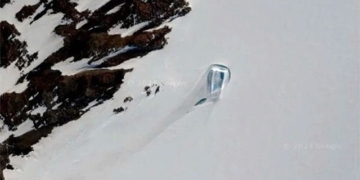Dating back at least 3,600 years, the Nebra Sky Disk is considered the oldest astronomical star map depicting celestial phenomena.
This disk represents the oldest known human depiction of the night sky. The Nebra Disk was used to measure the angle of the Sun at solstice points. Some hypotheses suggest that ancient Europeans deliberately buried it thousands of years ago. At that time, they had used this map for about 200 years and even made modifications to obscure certain stars and add symbols to better correspond with leap months.
Archaeologists from Goethe University Frankfurt and Ludwig Maximilian University in Munich have reanalyzed all data related to the reconstruction of the discovery site and the surrounding circumstances of where the ancient bronze disk was found.
The researchers’ findings indicate that the disk must date back to the Iron Age, meaning it is approximately 1,000 years younger than previously assumed. This revision renders all prior interpretations related to the Nebra Sky Disk outdated.
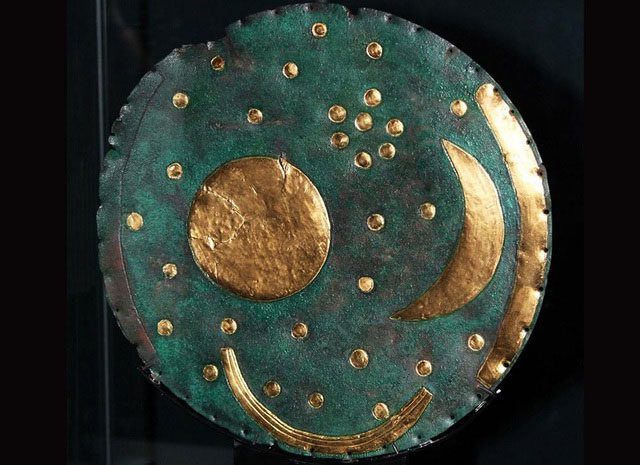
Nebra Sky Disk.
The Nebra Sky Disk is one of the most significant archaeological discoveries in Germany and was included in UNESCO’s Memory of the World Register in 2013. It was uncovered during an illegal excavation in 1999 alongside swords, axes, and bracelets from the Bronze Age.
Furthermore, the crude excavation and lack of knowledge of the antiquities hunting group damaged the outer rim of the disk and resulted in the loss of a piece of the golden arc and one of the stars. Despite the damage, the Nebra Disk was sold to an illegal antiquities dealer in Switzerland. It wasn’t until 2002 that experts were able to locate it.
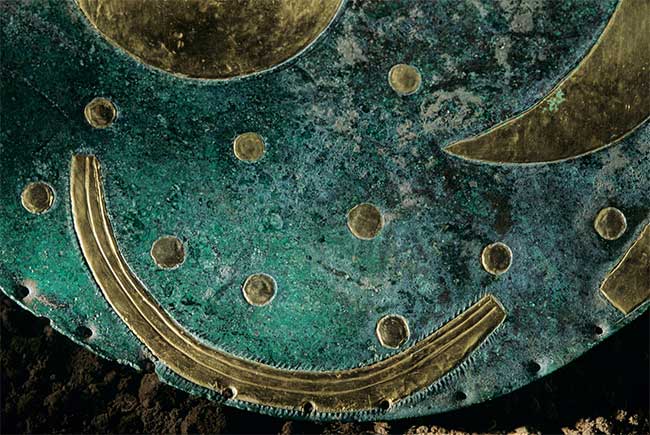
It was discovered during an illegal excavation in 1999.
The context of this discovery is crucial for scientific dating, as the disk itself cannot be scientifically or archaeologically dated when compared to other objects. Consequently, many years of investigation by several research groups have sought to verify the origin of the discovery site and the common origins of the objects independent of the vague information provided by the looters.
Initially, many believed the Nebra Sky Disk to be a forgery. For example, Richard Harrison, a professor of European history at the University of Bristol, stated in an interview, “When I first heard about the Nebra Disk, I thought it was just a joke; I really believed it was a counterfeit. Because it is such an extraordinary work that none of us would be surprised if it were created and sold by some skilled blacksmith for a high price.” Harrison’s skepticism at that time was entirely reasonable since he had never seen the disk. However, after the disk underwent detailed scientific analysis, it was proven to be genuine and a valuable artifact of humanity. In 2013, UNESCO recognized the Nebra Sky Disk as a documentary heritage, noting it as the “most specific and oldest depiction of cosmic phenomena in the world.”
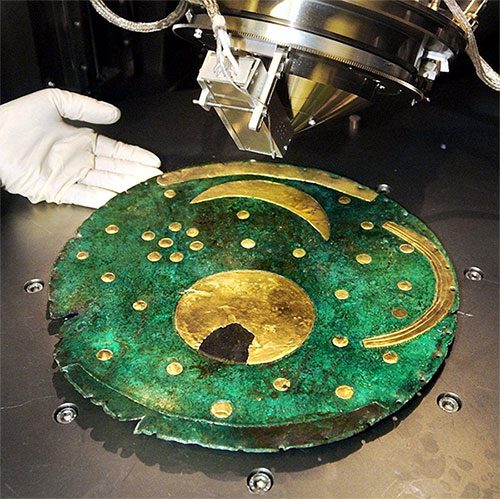
The disk underwent detailed scientific analysis and was proven to be genuine.
The Nebra Sky Disk is made of bronze, with a diameter of approximately 30 cm and a weight of 2.2 kg, covered in a blue-green patina. The disk is inlaid with gold symbols depicting images of a crescent Moon, the Sun or a full Moon, and 32 stars (the stars also form a cluster of seven believed to represent the Pleiades). Two golden arcs were added later on both sides of the disk with an opening angle of 82 degrees, accurately representing the Sun’s position in summer and winter at the latitude of Mittelberg (51°N). Meanwhile, a smaller arc at the bottom represents a solar boat with many oars. There are about 40 small holes, each approximately 3 mm in diameter, drilled around the edge of the disk, allowing users to easily attach it to a piece of cloth for outdoor use.
Each symbol on the disk is a part of the beliefs of ancient Europeans. The Sun was worshipped as a harbinger of life throughout Europe; the Moon was used as a symbol marking the passage of time. The solar boat represents the ancient European mythology that at night, the Sun was carried away by a boat.
The disk also indicates that its creators had connections with other cultures across Europe and beyond. The bronze used for the disk was sourced from ores mined in Central Europe, while the gold came from Cornwall in England or Transylvania in Romania. The design of the swords and axes found on the disk is typical of the Unetice culture, which spanned from central Germany to Poland and the Czech Republic. The spiral bracelets are similar to those found in Scandinavia and Ireland. The image of the Pleiades cluster is also found in ancient cultures from Mesopotamia to Greece.
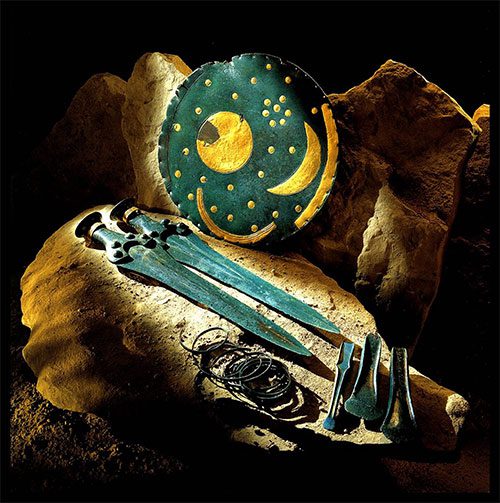
Each symbol on the disk is a part of the beliefs of ancient Europeans.
Most researchers believe that ancient Europeans used it as an astronomical clock to help them determine the right time (winter or summer) to start planting or harvesting crops. Accordingly, the Pleiades cluster was a guiding sign for farmers in ancient Mesopotamia and Greece, appearing in March and disappearing in October. Therefore, farmers in the region often relied on it for agriculture and livestock management.
Ancient scholars mapped the stars for thousands of years, evidenced by astronomical constructions such as the Goseck Circle and Stonehenge. This shows that humans have known about the stars and basic astronomical events such as solar and lunar eclipses since ancient times. However, based on previous findings, the earliest recorded image of a constellation was noted as early as 1400 BC in Egypt until the discovery of the Nebra Sky Disk.
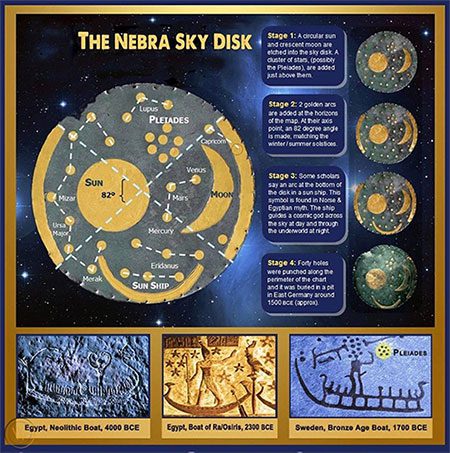
Humans have known about the stars and basic astronomical events such as solar and lunar eclipses.
Despite its fame and importance, many questions about the Nebra Sky Disk remain unanswered. For example:
- Who created it and what was its purpose?
- How was it used and by whom?
- What is its accuracy as an astronomical device?
- How did it end up on Mittelberg hill?
- Why was it buried and when?
- How did it survive for over 3,000 years without corrosion or destruction?
However, most experts agree that it is genuine and has a date around 1600 BC (making it 3,600 years old) based on scientific analyses of its materials, design, context, and astronomical features.
If the Nebra Sky Disk had been found in Egypt or Greece, where civilization had reached a certain level during the Bronze Age, it might not have been as intriguing. But the disk was discovered in Northern Europe, considered barbaric at that time, with no great cities, no forms of early writing, and no signs of philosophy. Everything that archaeologists had previously found in this area were swords, javelins, and a rather primitive society. Yet, the discovery of the Nebra Sky Disk has made people rethink entirely.
According to Harald Meller, director of the state museum in Halle, where the disk is housed: “Astronomical rules could not have been described without undergoing in-depth observation over many decades. Until the Nebra Sky Disk was discovered, no one thought that ancient people had such knowledge and astronomical precision.”















































